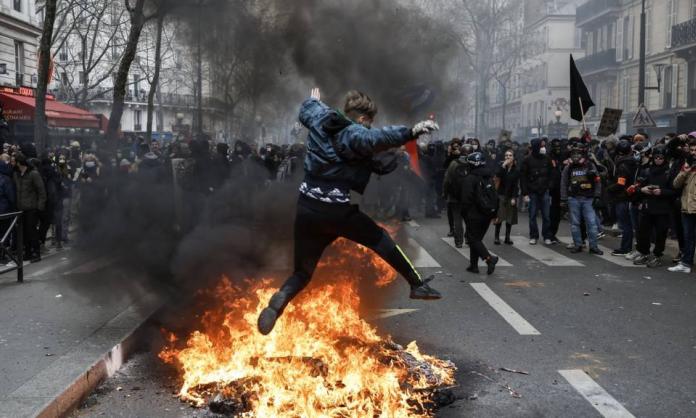Now entering its third month, the French workers’ movement against the government’s pension changes continues to gather steam. On 25 March, 2 million workers around the country took part in the tenth national day of protest called by the coalition of trade unions leading the fight.
While the turnout was a slight but expected dip from the peak experienced during the February demonstrations, the movement has been reinvigorated recently by wildcat strikes, spontaneous nightly demonstrations and—importantly—the entrance of university and high school students into the struggle, with their general assemblies, occupations and street protests.
Sentiment against President Emmanuel Macron’s law increasing the retirement age from 62 to 64 remains solid: less than a third of the population support the change, and 70 percent continue to back the demonstrations and strikes. The pension reform has become a symbol for Macron himself and his presidency, underscoring his perception in the public eye as “president of the rich”.
The increase in the retirement age will disproportionately affect the lowest paid and least educated sections of the working class, often concentrated in manual labour. It will also affect women workers, who are more likely to take time out of the workforce to have and raise children. When Macron says that the changes are “necessary”, workers understand that he means they’re the ones who need to make sacrifices, while the profits of French companies go untouched.
Significantly, however, the struggle against the change has moved beyond a simple economic question: it embodies Macron’s willingness to ride roughshod over democratic processes, and the dictatorship of capital at the heart of the French state.
To pass the reform, Macron and his prime minister, Élisabeth Borne, resorted to using the so-called 49.3—an article in the constitution that allows the president to pass laws by decree, bypassing parliament altogether. This undemocratic lever has been used 100 times since the current constitution was put in place in 1958; Borne has used it eleven times since her government was formed in May 2022, the second-highest of any French leader in 64 years.
By deploying 49.3, Macron showed his hand. Not only did he lack the confidence to cobble together a majority in the National Assembly. Immediately after the decree, a vote of no confidence in the government was lost by only a handful of votes. With Macron and Borne’s legitimacy in tatters, 49.3 was like kerosene to the burning anger of French workers and youth, who have since escalated the frequency of wildcat strikes and nightly demonstrations.
In a widely viewed television interview, Macron tried to paint these spontaneous protests as “seditious”, even going so far as to compare French protesters to the 6 January 2021 rioters who stormed the US Capitol, or Brazilian President Jair Bolsonaro’s supporters who trashed the Brazilian government complex when he lost the last election. In the same interview, Macron went on to argue that the pension change must be allowed to “follow its democratic path”.
Safeguarding the “democratic path” is one of the largest mobilisations of the police since the anti-Macron yellow vest movement of 2018-19. Since 49.3 was used on 16 March, there have been several instances of police violence, such as a man being hospitalised after the most recent day of action, and a 13-year-old with bruises all over his body, including where a tear gas canister hit just beneath his eye.
On the most recent day of action, 13,000 police were deployed in Paris alone. Worryingly, there has been an increase in arbitrary arrests, some of which seem pre-emptive. At one rally in Paris, there were a whopping 292 arrests, including two Austrian children on a school trip. Of the arrested, 238 were released and only nine charged.
This blatant disregard for democracy—including large-scale repression of protests—while claiming to champion democracy, is motivating key sections of the working class to keep mobilising. One such section is refinery workers, whose strikes and blockages have caused widespread fuel shortages nationwide. At the TotalEnergies refinery in Donges, in the west of France, workers have voted to renew their strike for the fifth consecutive week.
As one of their union delegates said, “The ‘democra-tatorship’ put in place by Borne-Macron isn’t making us back down, nor does it undermine our determination: the strike continues”.
Strikes have plagued a variety of industries with visible effects: garbage piling up in Parisian streets due to garbage collectors striking, school closures, cancelled flights, even the Louvre being shut for a day. Yet as French activist and sociologist Ugo Palheta points out, the sections of the workforce on strike are still concentrated in a few areas of the economy, namely the public and semi-public sectors. Despite the popularity of the mobilisation against the pension reform and the mass attendance at days of protest, many workers continue to work, especially in the private sector, where fear of losing pay can limit some workers’ willingness to take part.
So while the union days of action continue to provide calendar events for the movement to work towards—the next being 6 April—the spreading of the movement to other sectors is vital if victory against Macron and his law is to be realised. Turning the anti-Macron sentiment in French society into a deep and wide strike wave has the potential not only to block the pension reform but perhaps even to bring down Macron’s presidency altogether.










